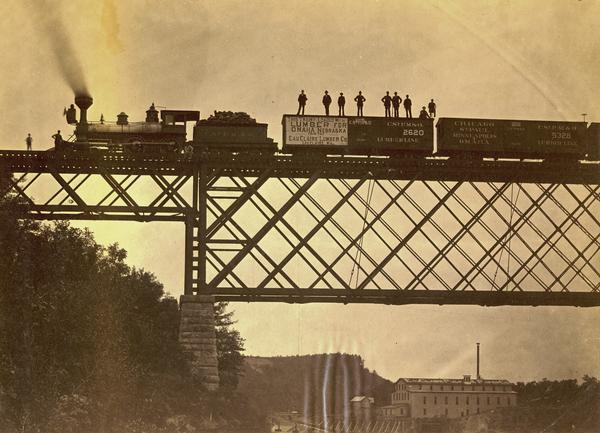The most unique and most visible bridge in the City of Eau Claire, this massive deck truss crosses high above the Chippewa River, north of Madison Street.
The first bridge at this location was built in 1872, and consisted of an uncovered wooden deck truss bridge. When that bridge became too light for traffic, a new bridge was designed by John Alden, chief engineer of Leighton Bridge & Iron Works. This new bridge would feature four massive quintuple intersection Lattice Deck Truss spans, each at 180 feet in length. Approaching these spans was a single 80-foot double intersection Warren Deck Truss on either side. New stone piers, built of Mankato limestone would be constructed for this bridge.
Work for the new bridge began in 1880, starting with the construction of the new piers, and the erection of the main deck trusses. Temporary trestle approaches were used until 1881, when the approach spans were installed. Standing at 82 feet above the Chippewa River, this new bridge became an instant icon for the railroad, and this bridge was incredibly important to the development of the City of Eau Claire.

Bridge in approximately 1881, showing original deck truss approaches. This may have been one of the first trains over the completed bridge.
In 1898, upgrades were sought to the bridge. While the main trusses were retained, the floor was replaced. In addition, new deck girder approaches were added on either end, fabricated by Lassig Bridge & Iron Works. By 1912, the bridge became too light for the heavy engines that used it. A new bypass was built to the north, and this bridge was reduced to an industrial spur.
After another 80 years of light service, the bridge was abandoned by the Chicago & North Western in 1882. Because of the high pressure gas line on the bridge, the abandoned bridge would continue to be used by Xcel Energy. When Union Pacific debated removing the bridge, Xcel purchased the bridge and transfered it to the City of Eau Claire. In 2014-2015, 1.15 Million Dollars were spent to transform the bridge into the landmark trail crossing it is today.
The importance of this bridge cannot be overstated. The main truss spans are believed to be the only remaining examples of quintuple intersection Lattice Deck Trusses in the country, as most similar trusses were built as quadruple intersection examples. In addition, only the bridge at Black River Falls, removed in the 1920s, has been found to use the same design. The use of riveted connections on this bridge is also an early technological feat, especially considering the rarity of field riveting at the time. Further features of the bridge included a tapered design, where the bottom of the main truss spans is actually wider than the top. This is a rather odd feature for a railroad bridge, and one the author has not seen elsewhere.
The use of the tapered design is likely due to the height of the trusses. A staggering 30 feet tall, these trusses are some of the most massive seen on an early railroad structure. Further significance is added to this bridge by the lack of significant alterations to the superstructure, as the only alterations occurred in the late 1890s.
After opening to the public in 2015, the bridge, now known as the "High Bridge" locally, became an instant icon, and a landmark to the City of Eau Claire. Because Eau Claire has such an excellent record preserving historic railroad bridges, there is a considerable collection of historic bridges remaining in the city.
Unfortunately, tragedy struck the bridge in late June 2021. After a tree limb damaged the railing on the bridge during a storm, a major buckle was found over the center pier. Investigations revealed the pier was failing, and the bridge was in immediate danger of collapse. Solutions were sought urgently, and for two weeks, it seemed the bridge would likely be demolished.
However, on July 13th 2021, the Eau Claire City Council unanimously accepted a proposal for emergency repairs on the bridge, which were expected to cost upwards of 3 million Dollars. The scope of the repairs included the replacement of the top portion of the failing piers, replacement of expansion joints, repairs of other stonework and other improvements.
The bridge reopened in March 2022, with a ribbon cutting ceremony on March 28th, 2022. This is one of the most unique and challenging examples of railroad bridge preservation the author has ever seen. This also should serve as an excellent example project to other agencies who are debating to remove or repair a historic bridge.
After the bridge closed, it was made very clear that this bridge is treasured by both the community and its leaders. The author would like to extend a special thank you to the Eau Claire City Council for voting to preserve this extremely historic structure.
The author has ranked this bridge as being nationally significant, due to the unique, one of a kind design, the landmark status and the excellent repair that was completed during the spring of 2022. The preservation of this bridge is critical, and the bridge represents an excellent example of transportation heritage that is truly one of a kind.
The photo above is an overview, and the photo below shows truss details. The photos taken show the bridge before and after the trail conversion. As work begins to repair this bridge, the author will continue to update this page.
| Upstream | UP Chippewa River Bridge |
| Downstream | Phoenix Park Railroad Bridge |
Detail Photos
